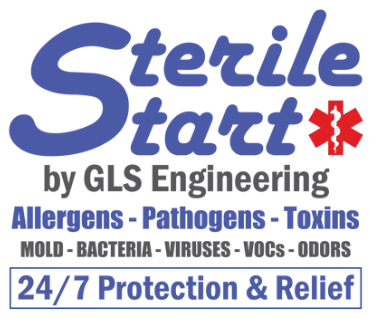Aspergillus - The Invisible Mold

Aspergillus is likely prevalent in your home without you knowing it and without any visible signs.
Aspergillus is the mold most commonly associated with health-related reactions and is also the most problematic mold in the Southeast. Most alarming is that Aspergillus is rarely visible. Undetected, it can saturate the air in your home with spores and mycotoxins that continuously wear on your immune system and result in a host of heath reactions.
SterileStart provides solutions that effectively keep Aspergillus at bay.
Aspergillus is rarely visible?? Under normal conditions, Aspergillus tends to grow uncolonized, meaning that active growth is not in one large, expanding mass. It can also be light in color and translucent, so individual spores are difficult to detect (they are about 3 microns in diameter). In fact, visible mold in your home or office is usually not Aspergillus, but is a conspicuous red flag that conditions are suitable for Aspergillus to thrive. Cleaning visible mold alone does little to address underlying Aspergillus and its airborne spores and mycotoxins.
So how prevalent is Aspergillus? Most people only think about mold when they have a water leak/flood or they see visible mold. Aspergillus, however, is present in concerning concentrations in a large percentage of Lowcountry homes and offices. In a recent study, of 40 homes tested in the Charleston area, 26 had Aspergillus counts greater than 700 spores per cubic meter (an accepted industry guideline for what would be considered "clean") and 37 had Aspergillus counts greater than 230 spores per cubic meter (a more stringent medical industry guideline). And only 3 out of the 40 met the criteria for both Aspergillus and Total spore counts (700 Asp/1000 Total) to be considered "clean".
Aspergillus can become active at fairly low relative humidity, meaning that properly air conditioned homes with good humidity control are not immune. Our research has shown that in almost all cases, Aspergillus makes up a significantly larger percentage of the total indoor spores as opposed to its percentage of total outdoor spores. It is not uncommon to find Aspergillus account for 85-100% of the total indoor spore count as opposed to Aspergillus accounting for only 3-15% of the total outdoor spore count. Indications are that Aspergillus spores originate from mold within the home, even thought there is no visible mold.
Additionally, Aspergillus spore are very small, allowing significant quantities to bypass even high efficiency pleated filters.
SterileStart is dedicated to making the public aware of this pervasive mold and its potential dangers, and to provide solutions for its active control.
Contact Us Today For Investigation & Mold Testing In Charleston & The Surrounding Areas!